Consumer Smart Wearable Market Size
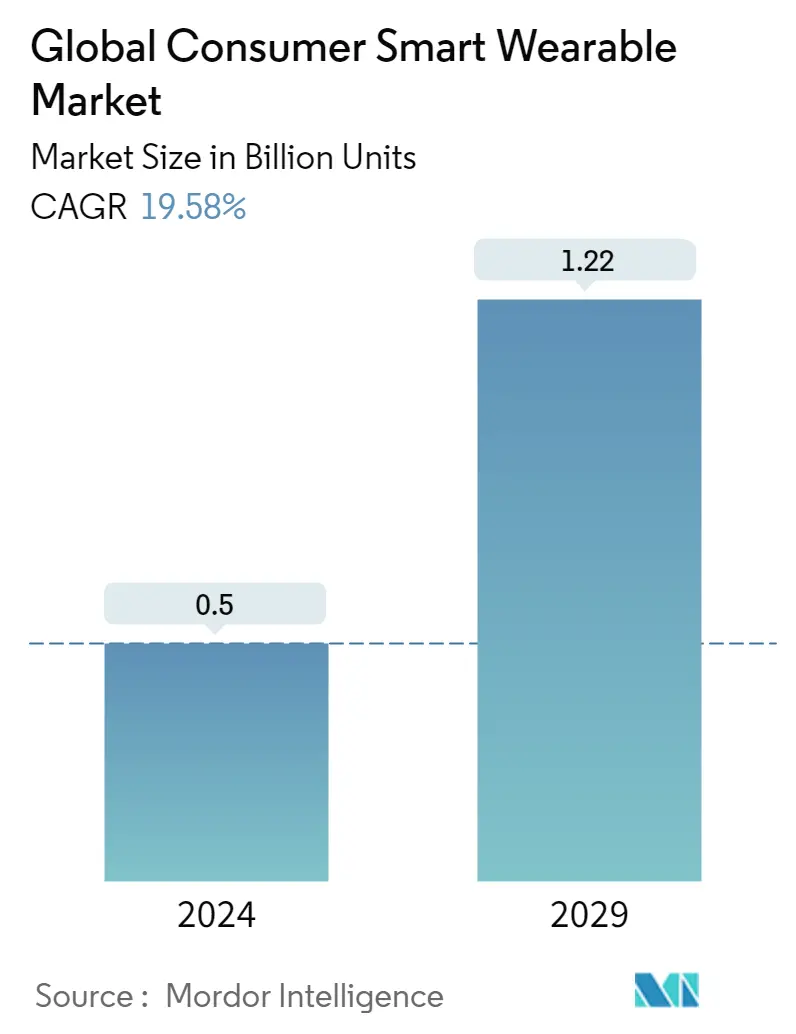
| Study Period | 2019 - 2029 |
| Base Year For Estimation | 2023 |
| CAGR (2024 - 2029) | 19.58 % |
| Fastest Growing Market | Asia-Pacific |
| Largest Market | Asia-Pacific |
| Market Concentration | Low |
Major Players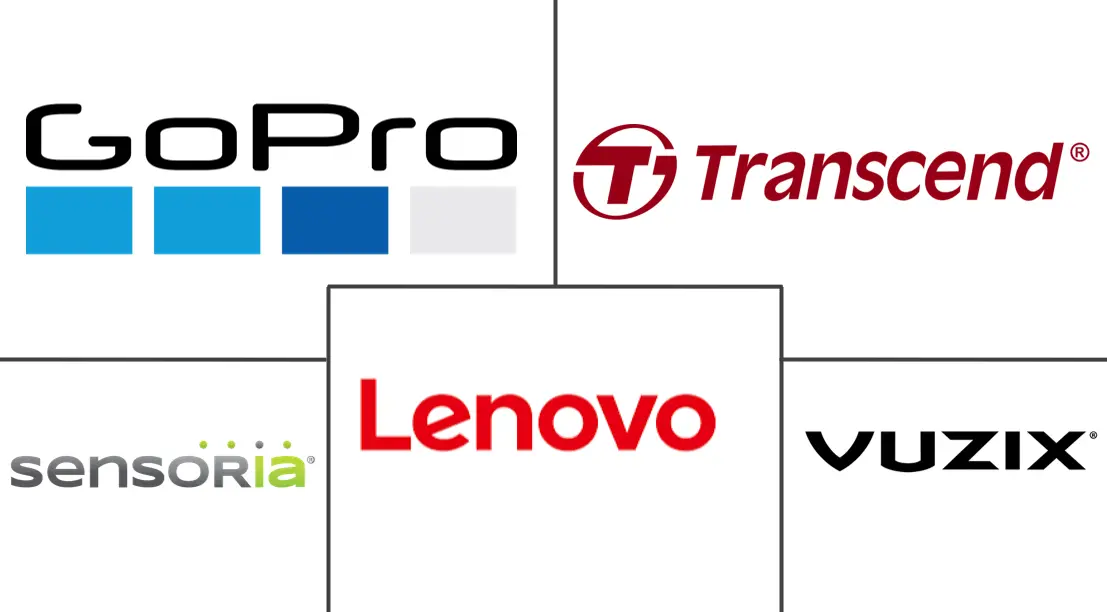
*Disclaimer: Major Players sorted in no particular order |
Consumer Smart Wearable Market Analysis
The Global Consumer Smart Wearable Market size is estimated at 0.5 Billion units in 2024, and is expected to reach 1.22 Billion units by 2029, growing at a CAGR of 19.58% during the forecast period (2024-2029).
Wearable technology, an emerging trend, integrates electronics into daily activities and addresses the changing lifestyles with the ability to be worn on any part of the body. Factors such as the ability to connect to the internet and provide data exchange options between a network and a device are leading to the trend of wearable technology.
- The rising penetration rates of urbanization in various parts of the world have driven the demand for advanced, aesthetically appealing products that possess the ability to serve the consumers' requirements better, such as multiple features in one device and time schedules. Moreover, the vast millennial population across the globe has been quick to adopt smartwatches, owing to the increased spending ability on their regular work hours tracking and luxury standards.
- Machine learning and AI capabilities take skills to the next level, especially in the current healthcare industry. In support of this, IoT compatibles smart wearable sensors are also witnessing a decline in pricing, which leads to manufacturers offering smart wearable devices at a more affordable rate, thus, encouraging various industries to adopt products catered to their systems and operations. Additionally, there has been a significant increase in consumer smart wearable devices being sold over the past few years. Additionally, wearable sensor devices have emerged to be a significant part of the sports industry, thereby helping customers to stick to daily routines and providing crucial information regarding the different parameters it is programmed to monitor.
- Smart wearables are further witnessing a surge in the number of new users, including the older age population, owing to the fact that wearable makers, such as Apple and Fitbit, among others, are adding health-monitoring features that appeal to old age people and keep them updated about their health status in real-time.
- Although the adoption of wearables has been widely gaining traction over the past few years, the concern over data privacy persists. Even though data from smart wearables may be of little value to attackers, the risk increases for smart wearables like smartwatches. Risks are likely to increase further if the device comes with an LTE connection, as they can be operated away from the paired device.
- The COVID-19 outbreak and the lockdown restrictions across the globe have affected the consumer across the world. Some of the effects of lockdown include supply chain disruptions, lack of availability of raw materials used in the manufacturing process, labor shortages, fluctuating prices that could cause the production of the final product to inflate and go beyond budget, and shipping problems, among others.
Consumer Smart Wearable Market Trends
This section covers the major market trends shaping the Consumer Smart Wearable Market according to our research experts:
Incremental Technological Advancements Aiding the Market Growth
- Increasing disposable incomes and changing lifestyles have led to the demand for wearable technology. Demand from industries like military, sports and fitness, healthcare, and entertainment, among others., have also increased due to the increased functionality wearables offer in the era of IoT.
- This demand has been supported by new product launches and new entrants into the market. As more companies venture into the consumer smart wearables market, the need for differentiating their product offerings becomes essential. For instance, in June 2022, Ambraneannounced its portfolio expansion with the Wise Roam smartwatch series launch. The smartwatch is offered with Bluetooth calling and provides 100+ cloud-based watch faces and is IP68 water-resistant.
- The Wise Roam smartwatch has sensors for heart rate, blood pressure, SpO2, menstrual health, sleep, and other wellness metrics. Additionally, it offers breath training, weather forecasts, High AR Alert, and sedentary reminders. The smartwatch offers more than 60 different sports modes and the Da Fit software, which works with both Android and iOS devices. Additionally, the wristwatch can be linked to Apple Health and Google Fit.
- Companies like LG Chem and Panasonic have been instrumental in developing printable and flexible batteries that can power wearable devices. Using these flexible and sleek designs of the batteries, vendors in the market were able to utilize the additional space to add more components and improve battery capacity, which translates into longer battery life.
- The growing advancement and reduction in the size of sensors, especially pressure sensors and activators, also expanded the scope of the consumer smart wearables market. Many companies are investing in developing advanced MEMS and digital sensors, which are further decreasing their sizes, hence covering a wide range of market applications.
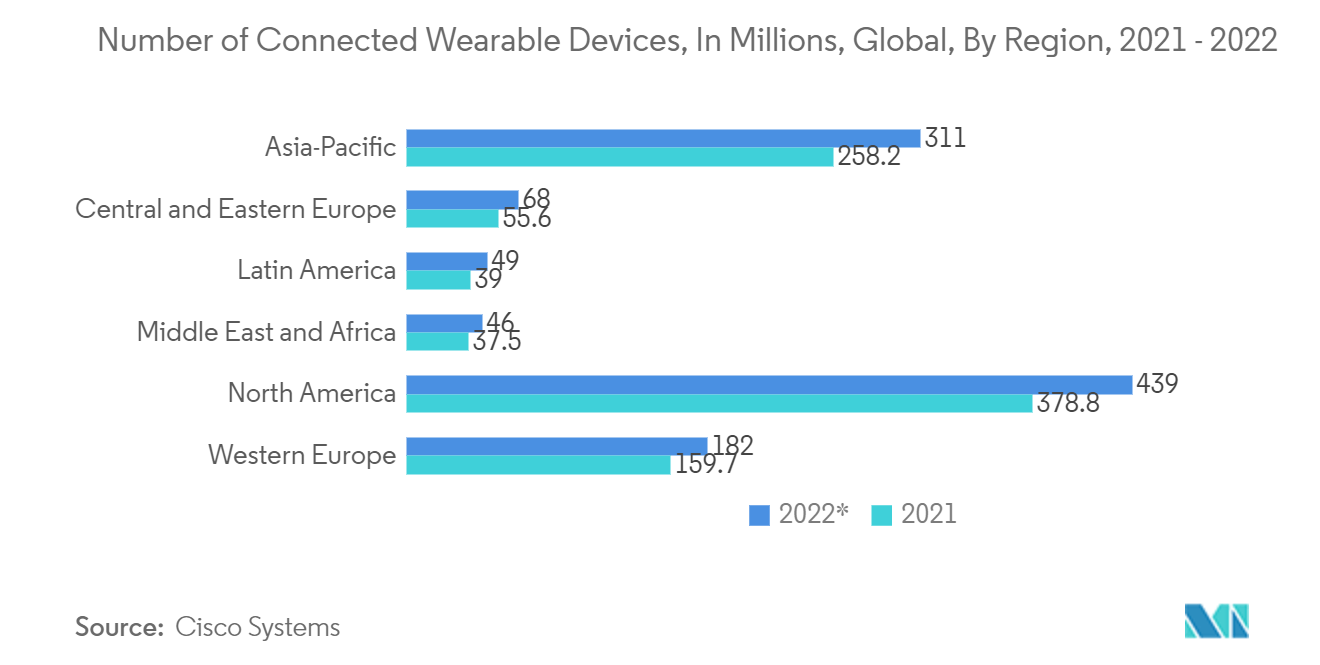
Asia Pacific is Expected to Register the Fastest Growth
- The government's support for making China one of the prominent innovation leaders compared to a low-cost manufacturing hub is also driving the market, as many Chinese companies are investing tremendously in research and development. For instance, KUMI successfully supplied 400 thousand smartwatches and moved internationally to compete in various markets, including India, the United States, Europe, and many Southeast Asian nations.
- Chinese companies are developing advanced technologies for the emerging market of wearable devices, such as fitness bands and smartwatches, with built-in connectivity. Device manufacturers, such as Xiaomi and Huawei, are very active in the market and are partnering with, as are online service providers, such as WeChat and mobile operators.
- In Japan, head-mounted displays (HMD) are becoming more advanced. An HMD, worn like a pair of goggles, projects video pictures directly in front of the user. Japanese firms have been producing HMD video entertainment systems with 3D capabilities one after the other. These systems combine computer graphics (CG), which Japan specializes in, with high-definition flat-panel display technology.
- According to the India Brand Equity Foundation (IBEF), the Indian appliances and consumer electronics (ACE) market is expected to register a 9% CAGR to reach INR 3.15 trillion (USD 48.37 billion) in 2022. This is expected to boost the consumer smart wearable market growth over the forecast period.
- Further, Asiatic FiberCorporation offers the iQmaxbrand of smart textiles, which aims to combine fiber with electronics to offer a functional, innovative product for use in apparel for a variety of markets. The iQmaxproduct line was developed with a lighting module, and it features an LED Yarn, a DC jack, and a two-in-one power battery and controller. The product line offers a textile for bendable, soft, lightweight, waterproof, and washable clothing that is also designed to endure folding over time.
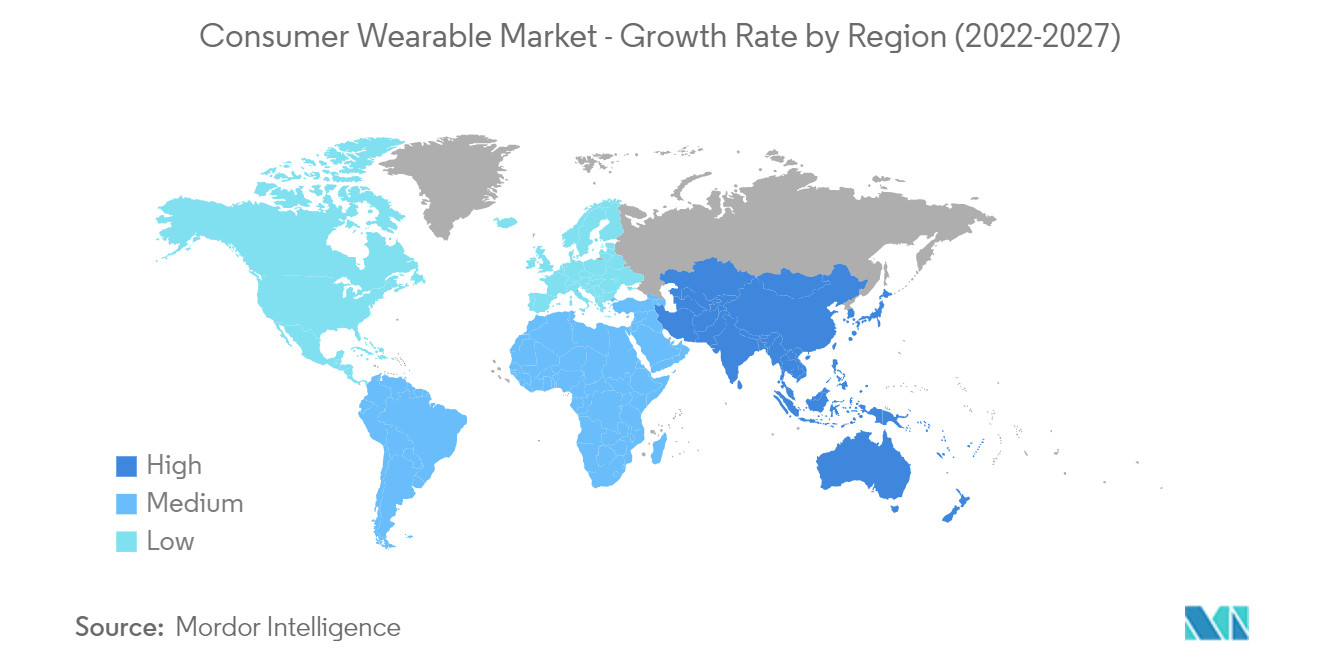
Consumer Smart Wearable Industry Overview
The Global Consumer Smart Wearable Market is highly competitive. The market has gained a competitive edge in recent years. Additionally, the players are being taken to gain a competitive edge in this fast-growing market, mainly catering to the demand from the millennial generation population. The companies are introducing new offerings and continuously investing in making partnerships and acquisitions along with product development to increase the market share.
- April 2022 - VuzixCorporation signed a distribution agreement with RobotiquesCyborg, a France-based multi-national distributor of high-technology solutions. As a part of the agreement, Vuzixhas received and shipped against an initial USD 300,000 order from the new partner for its smart glasses.
- August 2021 - Lenovo and RealWearannounced an international collaboration to bring assisted reality solutions to enterprise customers. The combination of resources and technologies of both companies will enable customers to select, deploy and scale the required extended reality (XR) technologies globally. According to the collaboration, Lenovo has certified the RealWearHMT-1 devices to utilize its ThinkRealityplatform to expand frontline workers' access to optimized, hands-free 2D applications. Further, the company will offer RealWear'sHMT-1 family of assisted reality wearable devices through its international sales network.
Consumer Smart Wearable Market Leaders
-
Vuzix Corporation
-
Lenovo
-
Transcend Information Inc.
-
GoPro Inc.
-
Sensoria Inc.
*Disclaimer: Major Players sorted in no particular order
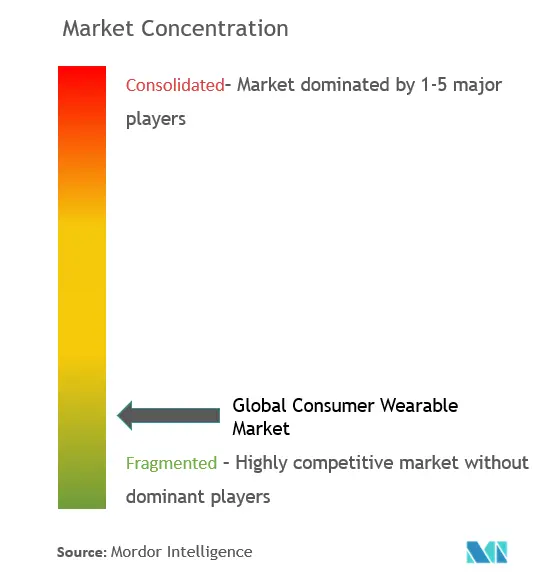
Consumer Smart Wearable Market News
- May 2022 - VuzixCorporation announced signing an agreement with Atomistic SAS (Atomistic), an mLED(micro-Light Emitting Diode) display solutions enterprise based in France. The agreement provides for the design of a custom backplane, an exclusive license of key mLEDtechnology, and the ability to acquire the enterprise, which depends upon achieving various technical phases. The Atomistic company will be delivering a backplane on advanced node 300mm wafers, along with system-level support from Vuzix, intended to support upcoming mLEDsbased upon its innovative material science and alternative LEDs from potential third-party suppliers. The mLEDswill be provided for AR glasses.
- April 2022 - NuhearaLimited and HP Inc entered a worldwide Trademark License Agreement to manufacture, develop, and market its hearing aid products under the HP brand trademarks. The company plans to span the HP branded hearing products into other large market opportunities worldwide, leveraging the advantage of the FDA enactment of the Over-The-Counter Hearing Aid rule accompanied by the delivery of excellent results from and the completion of the National Acoustic Laboratories Clinic Study competed in January 2022. This agreement does not interfere with the 3-year OEM HP Elite Buds manufacturing agreement.
Consumer Smart Wearable Market Report - Table of Contents
1. INTRODUCTION
- 1.1 Study Assumptions and Market Definition
- 1.2 Scope of the Study
2. RESEARCH METHODOLOGY
3. EXECUTIVE SUMMARY
4. MARKET INSIGHT
- 4.1 Market Overview
-
4.2 Industry Attractiveness-Porter's Five Forces Analysis
- 4.2.1 Bargaining Power of Suppliers
- 4.2.2 Bargaining Power of Buyers
- 4.2.3 Threat of New Entrants
- 4.2.4 Intensity of Competitive Rivalry
- 4.2.5 Threat of Substitutes
- 4.3 Value Chain Analysis
- 4.4 Impact of COVID-19 on the Consumer Smart Wearable Market
5. MARKET DYNAMICS
-
5.1 Market Drivers
- 5.1.1 Incremental Technological Advancements Aiding the Market Growth
-
5.2 Market Challenges
- 5.2.1 High Cost and Data Security Concerns
6. MARKET SEGMENTATION
-
6.1 By Product
- 6.1.1 Smartwatches
- 6.1.2 Head-mounted Displays
- 6.1.3 Smart Clothing
- 6.1.4 Ear Worn
- 6.1.5 Fitness Trackers
- 6.1.6 Body-worn Cameras
-
6.2 By Geography
- 6.2.1 North America
- 6.2.1.1 United States
- 6.2.1.2 Canada
- 6.2.2 Europe
- 6.2.2.1 United Kingdom
- 6.2.2.2 Germany
- 6.2.2.3 France
- 6.2.2.4 Rest of Europe
- 6.2.3 Asia Pacific
- 6.2.3.1 China
- 6.2.3.2 Japan
- 6.2.3.3 India
- 6.2.3.4 South Korea
- 6.2.3.5 Rest of Asia Pacific
- 6.2.4 Latin America
- 6.2.5 Middle East and Africa
7. COMPETITIVE LANDSCAPE
-
7.1 Company Profiles
- 7.1.1 Vuzix Corporation
- 7.1.2 Lenovo
- 7.1.3 Transcend Information Inc.
- 7.1.4 GoPro Inc.
- 7.1.5 Sensoria Inc.
- 7.1.6 AIQ Smart Clothing Inc.
- 7.1.7 Axon Enterprise Inc.
- 7.1.8 Withings
- 7.1.9 Huami Corporation
- 7.1.10 Omron Healthcare Inc.
- 7.1.11 Nuheara Limited
- 7.1.12 Polar Electro Oy
- 7.1.13 Microsoft Corporation
- 7.1.14 Sony Corporation
- 7.1.15 Huawei Technologies Co. Ltd
- 7.1.16 Fitbit LLC
- 7.1.17 Fossil Group Inc.
- 7.1.18 Garmin Ltd
- 7.1.19 Samsung Electronics Co. Ltd
- 7.1.20 Apple Inc.
- *List Not Exhaustive
8. INVESTMENT ANALYSIS
9. FUTURE OF THE MARKET
** Subject To AvailablityConsumer Smart Wearable Industry Segmentation
Wearable technology is an emerging trend that integrates electronics into daily activities and fits into the changing lifestyles, and it can be worn on any part of the body. The market is divided based on product types, such as a smartwatch, head-mounted displays, smart clothing, ear-worn, fitness trackers, and body-worn camera, which are mainly identified as consumer smart wearables.
The Global Consumer Smart Wearable Market is segmented by Product (Smartwatches, Head-mounted Displays, Smart Clothing, Ear Worn, Fitness trackers, Body-Worn cameras) and Geography.
| By Product | Smartwatches | |
| Head-mounted Displays | ||
| Smart Clothing | ||
| Ear Worn | ||
| Fitness Trackers | ||
| Body-worn Cameras | ||
| By Geography | North America | United States |
| Canada | ||
| By Geography | Europe | United Kingdom |
| Germany | ||
| France | ||
| Rest of Europe | ||
| By Geography | Asia Pacific | China |
| Japan | ||
| India | ||
| South Korea | ||
| Rest of Asia Pacific | ||
| By Geography | Latin America | |
| Middle East and Africa |
Consumer Smart Wearable Market Research FAQs
How big is the Global Consumer Smart Wearable Market?
The Global Consumer Smart Wearable Market size is expected to reach 0.50 billion units in 2024 and grow at a CAGR of 19.58% to reach 1.22 billion units by 2029.
What is the current Global Consumer Smart Wearable Market size?
In 2024, the Global Consumer Smart Wearable Market size is expected to reach 0.50 billion units.
Who are the key players in Global Consumer Smart Wearable Market?
Vuzix Corporation, Lenovo, Transcend Information Inc., GoPro Inc. and Sensoria Inc. are the major companies operating in the Global Consumer Smart Wearable Market.
Which is the fastest growing region in Global Consumer Smart Wearable Market?
Asia-Pacific is estimated to grow at the highest CAGR over the forecast period (2024-2029).
Which region has the biggest share in Global Consumer Smart Wearable Market?
In 2024, the Asia-Pacific accounts for the largest market share in Global Consumer Smart Wearable Market.
What years does this Global Consumer Smart Wearable Market cover, and what was the market size in 2023?
In 2023, the Global Consumer Smart Wearable Market size was estimated at 0.42 billion units. The report covers the Global Consumer Smart Wearable Market historical market size for years: 2019, 2020, 2021, 2022 and 2023. The report also forecasts the Global Consumer Smart Wearable Market size for years: 2024, 2025, 2026, 2027, 2028 and 2029.
Global Consumer Smart Wearable Industry Report
Statistics for the 2024 Global Consumer Smart Wearable market share, size and revenue growth rate, created by Mordor Intelligence™ Industry Reports. Global Consumer Smart Wearable analysis includes a market forecast outlook to 2029 and historical overview. Get a sample of this industry analysis as a free report PDF download.



